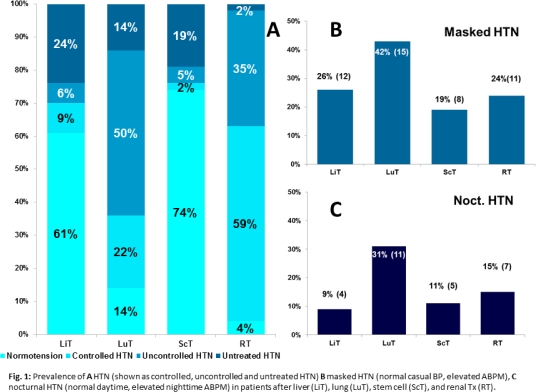High Prevalence of Hypertension and Alterations in Rhythmicity in Recipients of Pediatric Transplants
1Department of Pediatric Kidney, Liver and Metabolic Diseases, Hannover Med. School, Hanover, Germany
2Department of Medical Biometry, University of Heidelberg, Heidelberg, Germany
3Department of Pediatric Hematology and Oncology, Hannover Med. School, Hanover, Germany
4Department of Pediatric Pulmonology, Allergology, and Neonatology, Hannover Med. School, Hanover, Germany
5Department of Medical Sociology, Hannover Med. School, Hanover, Germany
6Department of Nephrology and Hypertension, Hannover Med. School, Hanover, Germany
7Division of Pediatric Nephrology, University Children's Hospital, Heidelberg, Germany.
Meeting: 2018 American Transplant Congress
Abstract number: B285
Keywords: Pediatric, Post-transplant hypertension
Session Information
Session Name: Poster Session B: Liver: Pediatrics
Session Type: Poster Session
Date: Sunday, June 3, 2018
Session Time: 6:00pm-7:00pm
 Presentation Time: 6:00pm-7:00pm
Presentation Time: 6:00pm-7:00pm
Location: Hall 4EF
Hypertension (HTN) is a major issue after transplantation (Tx). Ambulatory blood pressure (BP) monitoring (ABPM) permits the diagnosis of masked HTN and nocturnal HTN. Fourier analysis allows the characterization of BP rhythmicity. Our aim was to describe the prevalence of HTN in ped. liver (LiT), lung (LuT), stem cell (ScT), and renal tx (RT) recipients and to assess changes in rhythmicity in a case-control study. We prospectively assessed 172 patients (50% male; mean age 13±4 years) after LuT (n=36), LiT (n=46), ScT (n=44), and RT (n=46) Tx, and matched patients 1:3 for age and gender with a healthy cohort (n=516).
HTN affected almost all patients after RT (96%) and was also highly prevalent in patients after LuT (86%), LiT (39%) and ScT (26%). The frequency of untreated HTN was higher in the non-renal patients. Masked and nocturnal HTN were highest in LuT recipients.  Of note, in 48%, 67%, and 73% of all hypertensive LuT, LiT, and ScT patients hypertension was only detected by ABPM. Significant alterations in rhythmicity were seen in all cohorts, characterized by an increased mesor and an delayed 24-h-acrophase, whereas the 24-h-amplitude remained unchanged or even decreased. ABPM screening therefore is mandatory in transplanted children for diagnosing HTN. The underlying mechanisms of post-transplant hypertension are associated with an altered circadian rhythm.
Of note, in 48%, 67%, and 73% of all hypertensive LuT, LiT, and ScT patients hypertension was only detected by ABPM. Significant alterations in rhythmicity were seen in all cohorts, characterized by an increased mesor and an delayed 24-h-acrophase, whereas the 24-h-amplitude remained unchanged or even decreased. ABPM screening therefore is mandatory in transplanted children for diagnosing HTN. The underlying mechanisms of post-transplant hypertension are associated with an altered circadian rhythm.
CITATION INFORMATION: Memaran N., Kirchner M., Blöte R., Maecker-Kolhoff B., Goldschmidt I., Müller C., Epping J., Sugianto R., Borchert B., Schmidt B., Wühl E., Melk A. High Prevalence of Hypertension and Alterations in Rhythmicity in Recipients of Pediatric Transplants Am J Transplant. 2017;17 (suppl 3).
To cite this abstract in AMA style:
Memaran N, Kirchner M, Blöte R, Maecker-Kolhoff B, Goldschmidt I, Müller C, Epping J, Sugianto R, Borchert B, Schmidt B, Wühl E, Melk A. High Prevalence of Hypertension and Alterations in Rhythmicity in Recipients of Pediatric Transplants [abstract]. https://atcmeetingabstracts.com/abstract/high-prevalence-of-hypertension-and-alterations-in-rhythmicity-in-recipients-of-pediatric-transplants/. Accessed December 30, 2025.« Back to 2018 American Transplant Congress
